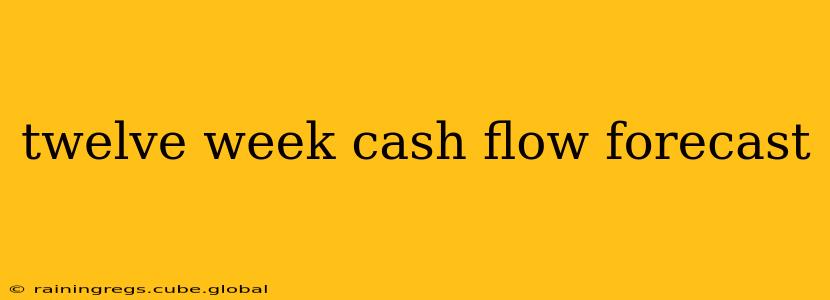A 12-week cash flow forecast is a crucial financial planning tool for any business, regardless of size. It provides a detailed projection of your expected cash inflows and outflows over the next three months, allowing you to identify potential short-term cash shortages or surpluses. This forecast helps you make informed decisions about spending, investment, and borrowing, ultimately improving your financial health and stability. This guide will walk you through the process of creating an effective 12-week cash flow forecast.
What is a 12-Week Cash Flow Forecast?
A 12-week cash flow forecast is a short-term financial projection that estimates the movement of cash into and out of your business over a three-month period. It's different from a longer-term budget, which focuses on profitability over a year or more. The focus here is on liquidity – ensuring you have enough cash on hand to meet your immediate obligations.
Why is a 12-Week Cash Flow Forecast Important?
A well-prepared 12-week cash flow forecast offers numerous benefits:
- Identify Potential Shortfalls: Early identification of potential cash flow problems allows you to proactively seek solutions, such as negotiating payment terms with suppliers or securing short-term loans.
- Improved Financial Management: Regularly reviewing your cash flow forecast helps you track your financial performance against your projections, allowing for course correction as needed.
- Informed Decision Making: The forecast provides the data you need to make informed decisions about investments, expansion, hiring, and other significant expenditures.
- Secure Funding: Lenders and investors often require a cash flow forecast to assess the financial health and viability of a business before approving loans or investments.
- Strategic Planning: The forecast facilitates better strategic planning by providing a clear picture of short-term financial prospects.
How to Create a 12-Week Cash Flow Forecast
Creating a comprehensive 12-week cash flow forecast involves several key steps:
-
Gather Data: Collect all relevant financial information, including past sales data, expected sales for the next 12 weeks, purchase orders, outstanding invoices, expected payments from customers, and scheduled loan repayments.
-
Project Cash Inflows: Estimate your anticipated cash inflows for each week. This includes sales revenue, payments received from customers, loan proceeds, and any other sources of cash coming into your business. Be realistic and consider seasonal variations or potential fluctuations in demand.
-
Project Cash Outflows: Estimate your anticipated cash outflows for each week. This includes payments to suppliers, employee wages, rent, utilities, loan repayments, taxes, and other expenses. Again, be realistic and factor in any potential increases in costs.
-
Calculate Net Cash Flow: For each week, subtract your projected cash outflows from your projected cash inflows. This gives you your net cash flow for that week. A positive net cash flow indicates a surplus, while a negative net cash flow indicates a deficit.
-
Calculate Cumulative Cash Flow: Add the net cash flow for each week to the previous week's cumulative cash flow. This shows your running cash balance throughout the 12-week period.
-
Analyze and Adjust: Review your forecast regularly and make adjustments based on actual performance. Unexpected events can significantly impact cash flow, so flexibility is key.
What information should be included in a 12-Week Cash Flow Forecast?
A comprehensive 12-week cash flow forecast should include the following:
- Week Number: Clearly identify each week of the forecast period.
- Cash Inflows: Detail all sources of cash inflow, with separate lines for each source (e.g., sales, client payments, loans).
- Cash Outflows: Detail all sources of cash outflow, with separate lines for each expense (e.g., salaries, rent, supplier payments).
- Net Cash Flow: The difference between inflows and outflows for each week.
- Cumulative Cash Flow: The running total of cash on hand at the end of each week.
- Opening and Closing Balances: The starting and ending cash balances for the 12-week period.
How often should I update my 12-week cash flow forecast?
Ideally, you should update your 12-week cash flow forecast weekly or at least monthly. More frequent updates allow you to react quickly to changes in your business environment and make necessary adjustments to your financial plan.
What if my 12-week cash flow forecast shows a deficit?
A projected deficit highlights a potential cash shortage. You'll need to develop a plan to address this, which might include:
- Negotiating payment terms with suppliers: Ask for extended payment periods to delay outflows.
- Accelerating invoice collections: Follow up with clients to receive overdue payments promptly.
- Cutting unnecessary expenses: Identify areas where you can reduce spending.
- Securing a short-term loan: Borrow money to cover the shortfall.
By diligently creating and regularly monitoring a 12-week cash flow forecast, you can significantly improve your business's financial health and stability, paving the way for sustained growth and success. Remember, this is a dynamic tool, requiring consistent review and adaptation to ensure its accuracy and effectiveness.
